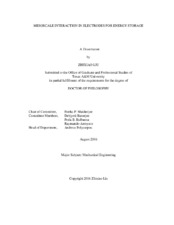| dc.description.abstract | The electrode microstructure in rechargeable lithium batteries, particularly Lithium-ion battery and Lithium-sulfur batteries, plays an important role in determining the adhesive strength and electrochemical performance of the battery. The overall objective of the present research is to develop mesoscale computational models to understand the effects of mesoscale interactions on electrode structure evolution.
For Lithium-ion battery, the electrode microstructure is significantly affected by the multiphase slurry properties and solvent evaporation. The most important slurry properties are nanoparticle loading, interparticle interactions, and the shape and the size of nanoparticles. Computational results from the present study indicate that the small-sized active material nanoparticles are beneficial to improve the electronic conductivity of electrode microstructure due to its high conductive interfacial area ratio, and high evaporation rate is harmful for achieving good cooperation between the active material and conductive additives. The mixing sequence also affects electrode microstructure. It is found that stepwise mixing sequence can significantly increase the conductive interfacial area ratio in the electrode microstructure to reduce resistance.
A severe challenge for Lithium-sulfur battery is that the discharge product Li2S is an insulator for both electrons and Li ions. The precipitation of Li2S varies porosity and tortuosity of cathode microstructure and corresponding electrochemical properties. In this research, it is proposed to develop a mesoscale modeling strategy to investigate Li2S precipitation-electrode interactions. A first-principle study is performed to fundamentally understand the interaction mechanism between polysulfides and solid Li2S substrate. Results reveal that Li2S molecule direct deposition is energetically favored over the Li2S2 molecule deposition/reduction process. Li2S film formation on graphene is also studied by the first-principles approach and it is found that Li2S molecule adsorption on graphene is weaker than adsorption on crystalline Li2S surface. Atomic structure evolution of Li2S film formation on graphene is also studied by first-principle calculation. It is found that Li2S (111) layer on the graphene is energetically favored. Based on results from first-principles calculations, a coarse-grained model accompanied by kinetic Monte Carlo algorithm is developed to study cathode surface passivation caused by Li2S precipitation, which is affected by reactants concentrations, electrode porosity, electrolyte/solid interfacial area, and operating temperature. | en |


